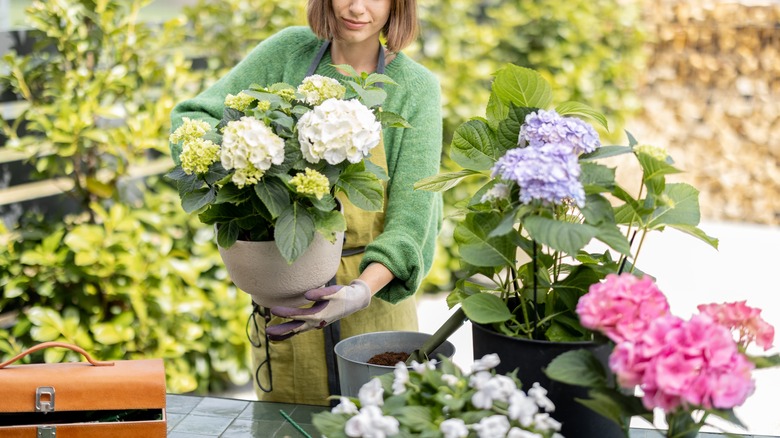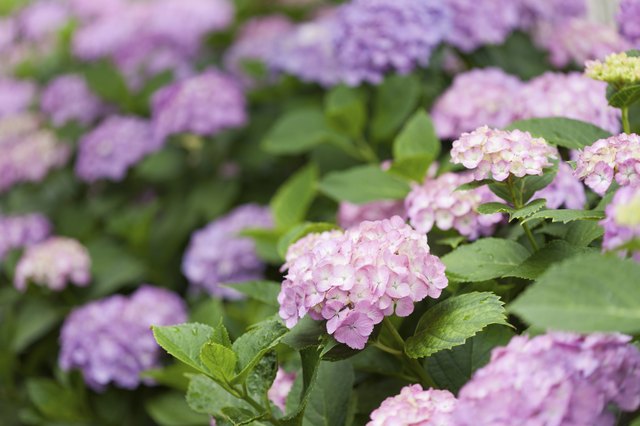Choosing the Right Time to Split
When it comes to splitting hydrangea plants, timing is everything. The best time to split hydrangea plants depends on the climate and region you are in, as well as the specific type of hydrangea plant you are working with. In general, spring and fall are considered the best seasons to split hydrangea plants, as the weather is typically mild and there is ample moisture in the soil.
In the spring, it’s best to wait until the plant has finished blooming and the new growth has begun to emerge. This is usually around late March or early April, depending on your location. In the fall, the best time to split hydrangea plants is about 6-8 weeks before the first frost, which is usually around late August or early September.
Before splitting your hydrangea plant, it’s essential to check for dormancy. Hydrangea plants typically go dormant during the winter months, and splitting the plant during this time can cause damage to the roots. To check for dormancy, gently dig around the base of the plant and inspect the roots. If the roots are dry and brittle, it’s best to wait until the plant has emerged from dormancy before splitting.
Once you’ve determined the best time to split your hydrangea plant, it’s essential to prepare the plant for the process. This includes watering the plant thoroughly the day before splitting, as well as pruning any dead or damaged branches. By preparing the plant properly, you can ensure a successful split and promote healthy growth and blooming.
Preparing Your Hydrangea for Splitting
Before you can successfully split your hydrangea plant, you need to prepare it for the process. This involves several steps that will help ensure the plant is healthy and strong enough to withstand the division. One of the most important steps is to prune the plant. Pruning helps to remove any dead or damaged branches, which can help prevent the spread of disease and encourage healthy growth.
Watering is also crucial when preparing your hydrangea plant for splitting. Make sure to water the plant thoroughly the day before splitting, as this will help to loosen the soil and make it easier to dig up the roots. It’s also a good idea to fertilize the plant a few weeks before splitting, as this will help to promote healthy growth and development.
Having clean and sharp tools is also essential when preparing your hydrangea plant for splitting. Use a sharp, sterile knife or pruning saw to cut through the roots and stems, and make sure to disinfect the tools between cuts to prevent the spread of disease. A garden fork or spade can also be used to gently dig up the roots and separate the sections.
It’s also important to consider the timing of the split. As mentioned earlier, the best time to split hydrangea plants is in the spring or fall, when the weather is mild and there is ample moisture in the soil. Avoid splitting the plant during the hot summer months or during periods of drought, as this can cause stress to the plant and lead to poor growth.
By following these steps and preparing your hydrangea plant for splitting, you can help ensure a successful division and promote healthy growth and development. Remember to be patient and gentle when handling the plant, and don’t hesitate to seek advice if you’re unsure about any part of the process.
Step-by-Step Instructions for Splitting Hydrangea Plants
Now that you’ve prepared your hydrangea plant for splitting, it’s time to start the process. Here’s a step-by-step guide on how to split hydrangea plants:
Step 1: Dig up the entire plant, making sure to get as much of the root system as possible. Use a garden fork or spade to gently loosen the soil around the plant, then lift it out of the ground.
Step 2: Examine the roots and identify the natural divisions between the sections. Hydrangea plants typically have a central stem with multiple branches, and each branch can be separated from the others.
Step 3: Use a sharp, sterile knife or pruning saw to cut through the roots and stems, separating the sections. Make clean cuts just above a growth node, and avoid tearing or ripping the roots.
Step 4: Replant the sections immediately, making sure to provide enough space for each section to grow. Plant the sections at the same depth as the original plant, and water thoroughly.
Step 5: Water the newly split plants regularly, keeping the soil consistently moist but not waterlogged. Fertilize the plants with a balanced fertilizer, and prune them regularly to encourage healthy growth.
When splitting hydrangea plants, it’s essential to handle the roots with care. Avoid damaging or breaking the roots, as this can cause the plant to become stressed and potentially lead to disease or pest problems.
By following these steps and taking the time to properly split your hydrangea plant, you can enjoy multiple plants with beautiful blooms and a healthy, thriving root system.
Post-Splitting Care: Tips for Success
After splitting your hydrangea plant, it’s essential to provide the right care to ensure the new sections thrive. Here are some tips to help you succeed:
Watering: Keep the soil consistently moist but not waterlogged. Hydrangea plants prefer well-draining soil, so make sure the pot or garden bed has good drainage holes. Water the plants regularly, especially during the first few weeks after splitting.
Fertilizing: Feed the new sections with a balanced fertilizer, such as a 10-10-10 formula. This will provide the necessary nutrients for healthy growth and blooming. Avoid over-fertilizing, as this can cause more harm than good.
Pruning: Prune the new sections regularly to encourage healthy growth and promote blooming. Remove any dead or damaged branches, and cut back the stems to maintain a desired shape or size.
Monitoring: Keep an eye out for pests and diseases, such as aphids, whiteflies, and powdery mildew. Use organic or chemical controls as needed to prevent infestations and infections.
Common mistakes to avoid include over-watering, under-fertilizing, and neglecting to prune the plants regularly. By following these tips and providing the right care, you can enjoy thriving hydrangea plants with beautiful blooms.
When learning how to split hydrangea plants, it’s essential to remember that the new sections will require time to establish themselves. Be patient and provide the right care, and you’ll be rewarded with healthy, thriving plants.
Troubleshooting Common Issues with Split Hydrangea Plants
When learning how to split hydrangea plants, it’s essential to be aware of the potential issues that may arise. Here are some common problems and solutions to help you overcome them:
Root Shock: This is a common issue when splitting hydrangea plants, especially if the roots are damaged during the process. To prevent root shock, make sure to handle the roots with care and avoid damaging them. If you notice any signs of root shock, such as yellowing leaves or wilting, reduce watering and fertilizing until the plant recovers.
Transplant Shock: This is another common issue when splitting hydrangea plants, especially if the new sections are not given enough time to establish themselves. To prevent transplant shock, make sure to provide the right care, including watering, fertilizing, and pruning. If you notice any signs of transplant shock, such as droopy leaves or slow growth, provide extra care and attention until the plant recovers.
Pest Infestations: Pests such as aphids, whiteflies, and spider mites can infest hydrangea plants, especially when they are stressed or weakened. To prevent pest infestations, inspect the plants regularly and use organic or chemical controls as needed. Make sure to follow the instructions carefully and take necessary precautions to avoid harming the plants.
By being aware of these common issues and taking steps to prevent them, you can ensure the success of your hydrangea plant splitting project. Remember to provide the right care and attention, and don’t hesitate to seek advice if you’re unsure about any part of the process.
Sharing Your Hydrangea Plants with Friends and Family
One of the joys of growing hydrangea plants is sharing them with others. Whether you’re giving a plant to a friend or family member, or sharing cuttings with a fellow gardener, sharing hydrangea plants can bring people together and spread beauty and joy.
To share your hydrangea plants, start by preparing the plant for transport. This includes watering the plant thoroughly, then allowing the soil to dry slightly to prevent waterlogged soil during transport. You can also trim back the stems to make the plant more compact and easier to handle.
When packaging the plant, use a sturdy box or container that can support the weight of the plant. Add some packing material, such as paper or bubble wrap, to prevent the plant from shifting during transport. You can also include a care instruction sheet to help the recipient care for the plant.
When giving a hydrangea plant to someone, consider adding a personal touch, such as a gift card or a handwritten note. This can make the gift even more special and meaningful to the recipient.
Sharing hydrangea plants can also be a great way to connect with other gardeners and plant enthusiasts. Consider joining a local gardening club or online community to share your knowledge and passion for hydrangea plants with others.
By sharing your hydrangea plants with others, you can spread the joy of gardening and help others experience the beauty and rewards of growing these stunning plants.
Conclusion: Enjoy Your Thriving Hydrangea Plants
Splitting hydrangea plants is a simple and effective way to promote healthy growth, increase blooms, and share plants with friends and family. By following the steps outlined in this guide, you can successfully split your hydrangea plants and enjoy the many benefits they have to offer.
Remember to choose the right time to split your hydrangea plants, prepare them properly, and provide the right care after splitting. With a little patience and attention, you can enjoy thriving hydrangea plants that bring beauty and joy to your garden.
Whether you’re a seasoned gardener or just starting out, splitting hydrangea plants is a great way to expand your garden and share your passion with others. So why not give it a try? With the right techniques and a little practice, you can become a hydrangea plant splitting pro and enjoy the many rewards of growing these stunning plants.
By following the tips and techniques outlined in this guide, you can successfully split your hydrangea plants and enjoy the beauty and rewards of growing these stunning plants. Happy gardening!
Conclusion: Enjoy Your Thriving Hydrangea Plants
Splitting hydrangea plants is a simple and effective way to promote healthy growth, increase blooms, and share plants with friends and family. By following the steps outlined in this guide, you can successfully split your hydrangea plants and enjoy the many benefits they have to offer.
Remember to choose the right time to split your hydrangea plants, prepare them properly, and provide the right care after splitting. With a little patience and attention, you can enjoy thriving hydrangea plants that bring beauty and joy to your garden.
Whether you’re a seasoned gardener or just starting out, splitting hydrangea plants is a great way to expand your garden and share your passion with others. So why not give it a try? With the right techniques and a little practice, you can become a hydrangea plant splitting pro and enjoy the many rewards of growing these stunning plants.
By following the tips and techniques outlined in this guide, you can successfully split your hydrangea plants and enjoy the beauty and rewards of growing these stunning plants. Happy gardening!




:max_bytes(150000):strip_icc()/leafpruning-5851b3685f9b586e025c8b43.jpg)


